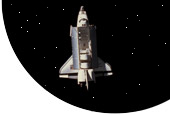Loading |
 |
|
||||||||||||||||||||||||||||||||||||||||||
News Analysis Looking like something out of a Japanese sci-fi cartoon, the futuristic space plane dropped from its mother ship 14 kilometers above Edwards Air Force Base, east of Mojave, Calif., and lit its rocket engine. The winged craft shot straight up, up, and still up, marked by a milky white smoke trail. It didn't curve toward any horizon, the way most rockets do, as they head toward a stable orbit as quickly as possible. More than 30 000 viewers in the desert tilted their heads back farther and farther, mouths agape, necks starting to ache, for the 76 seconds that pilot Michael W. Melvill let the engine burn. It was the most momentous suborbital hop since Alan Shepard rode his Freedom 7 capsule to an altitude of 187.4 km in 1961. IEEE Spectrum was on hand at Mojave Airport in California on 21 June for the launch of the unusual privately funded space plane, SpaceShipOne, which was designed by Burt Rutan and his team at Scaled Composites LLC in Mojave. Paul Allen, Microsoft Considering they spent more than twice as much money as they could win, clearly they were looking to participate in a future of commercial space travel for ordinary—albeit rich—people. For two minutes after engine shutdown, the vehicle "fell" upward, second by second losing speed to Earth's gravity, and all the while in free fall, the fabled zero gravity of astronaut lore. Melvill topped out just above the internationally recognized legal boundary of outer space—100 km—and then began the long plunge earthward. Then it was several more minutes of free fall before hitting the atmosphere and beginning the slowdown, followed by the long glide that brought the space plane and its pilot safely back to Mojave Airport as its mother ship and two chase planes performed a proud flyover. This was the 14th piloted flight in SpaceShipOne's test program, the highest and, at more than 4000 km/h, the fastest. And, befitting a test program, for an innovative flying craft, two significant anomalies cropped up that will set back Rutan's formal try at the X Prize for several months. There were surprises—unpleasant, as is usually the case—in flight control and aerodynamic effects. But nobody doubts that Rutan's team can overcome them with the mix of inspiration and intuition that has taken them this far. "Most people avoid chaos," explained Dick Rutan, Burt's older brother, "but Burt will dive right into it in search of solutions." He recalled many times when the two were growing up and Burt came up with strange ideas. Dick would shake his head and mutter, "It'll never work." But usually it did. Dick Rutan was the pilot who flew Burt's Voyager vehicle around the world without refueling in 1986. He's flown most of his brother's several dozen other original airplanes and has trained on the simulators for SpaceShipOne. In an exclusive interview with Spectrum, he described the new vehicle. "It's a squirrelly airplane to fly," he explained, adding, "it's always on the edge." But the pilot really has no choice but to fly it manually, he explained, because there is no autopilot (nor, for that matter, is there a parachute). The test program bears out this observation, with SpaceShipOne performing erratically, flirting with stalls, and even at one point leaving the runway during landing, bouncing back, and collapsing one landing gear strut. But each problem was diagnosed and repaired before the next flight. It was no wonder, then, that the 21 June flight had many exciting surprises. Seven seconds after the vehicle disengaged from the mother ship, there was a left roll because of 110-km/h wind shear. At 68 seconds, Melvill had to counter the effects of nozzle erosion with a difficult trim maneuver. Most frightening for the test pilot was a loud bang halfway through powered flight, and a close second was the hurricane-like sound during the Mach 2.9 reentry. Altogether, despite anomalies that knocked the vehicle off its landing trajectory by 42 km, Melvill was able to find the runway and come in smoothly. Even to the eye, SpaceShipOne is unusual. When dropped from the carrier plane, the teardrop-shaped fuselage with its trailing twin tails looks like something out of a Flash Gordon serial from the 1930s. The insides of the 2800-kilogram craft are just as surprising, including a propulsion system based on what can loosely be called rubber and laughing gas—but it's no joke. Its engine, provided by another maverick team of space innovators at SpaceDev Inc., Poway, Calif., is the first "hybrid engine" used for human space flight. A solid burnable material is provided in a lightweight casing, superficially similar to a traditional solid-fuel engine. But in those designs, the oxidizing chemical is also mixed in with the fuel. With the hybrid engine, the oxidizer is a gas—nitrous oxide, or N2O—that is piped into the casing during the burn. The reaction produces thrust, although not quite as efficiently as some advanced engines used in space programs. But the design offers the advantages of much lower cost and greater safety than those engines—the materials are chemically inert and easy to store before flight. And unlike the solid rocket booster of the Space Shuttle, for example, SpaceShipOne's engine can be turned off manually by just closing the inlet valve from the N2O tank. Designing an aerospace craft to operate across a vast range of air speeds with major changes in center of mass as the fuel burns was another daunting challenge. Rutan solved this problem for SpaceShipOne by actually hinging the aft fuselage. The twin tails swing upward once the rocket burn is complete, so that when the craft falls back into the atmosphere, the trailing tails keep the craft's bottom (with its special heat shield) facing into the wind. Once the air speed drops enough, the tails swing back down into their normal glide position. Rutan calls this his "carefree re-entry" design, and it was what he was most proud of at the post-flight press conference. No other spacecraft in the world is known to use the technique [but for other ideas, see sidebar, "In the Final Stretch..."]. Despite the media hype about private spaceflight, it must be kept in mind that there remains an enormous performance gap between SpaceShipOne and orbital manned space vehicles in the Rutan is famous for providing minimal insights to outsiders about his projects while they are in development ("If I had to keep you all informed about what I was working on," he told reporters, "it would take me twice as long to get it done"). At the press event after the flight, he mused in general terms about what a profitable "up-down space tourism" vehicle should be like. "If you are going to a space resort," he explained, "it's okay to use a cramped 'space van' to get there." But for suborbital hops, there's no destination resort and the rocket you ride has to be the one you vacation in. So you need more room, he explained, and "a big window for every passenger." You need a large open volume for people to float freely in—and to get maximum benefit, you need flights with more than five minutes of zero gravity. During visual presentations to pilots' associations, he has briefly flashed a picture of such a cabin on the screen—but will not discuss whether any client is paying him to build that kind of vehicle. Before aiming that high (perhaps with SpaceShipTwo), Rutan clearly needs to modify SpaceShipOne, as the problems revealed by that test flight testify. Against these difficulties, Final tracking showed that despite the two major anomalies, the flight did indeed achieve "astronaut status'' for the pilot. But the margin was only 120 meters, which might be interpreted as very nearly failing. The tiny margin meant that legally, Melvill only spent 10 seconds in space, by the lawyer's definition, about as close to not getting there at all as he could have gotten. On the other hand, it showed that Rutan's instinctive guess was enough, but not, wastefully, too much—which seems to be a general characteristic of all his flight programs so far. —JAMES OBERG A Giant Leap For Commercial Space Travel Of the almost two dozen registered X Prize contenders, some are clearly too amateurish ever to fly, but many are highly innovative and credible. · ARMADILLO AEROSPACE in Mesquite, Texas, is a small team funded by computer gaming mogul John Carmack. The team has designed a vertical takeoff and vertical landing (VTOVL) craft powered by hydrogen peroxide, and they've made a number of scale-model test flights. The 34-year-old Carmack approached the challenge by developing the rocket control software first, then building flight hardware. Steering is achieved by rapid-fire, high-precision throttling of the craft's four engines. A subscale model recently made an impressively smooth liftoff, hover, and return to its launch pad, all under autopilot control. ·
|
home | profile | articles | books | lectures | jim speaks | humor
links | email
Copyright 2010 James Oberg. All Rights Reserved
Site Designed and Maintained by YoeYo.com
